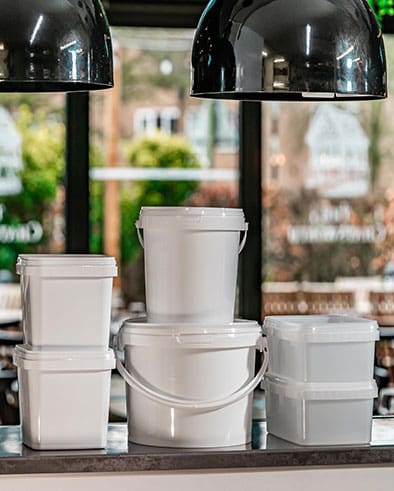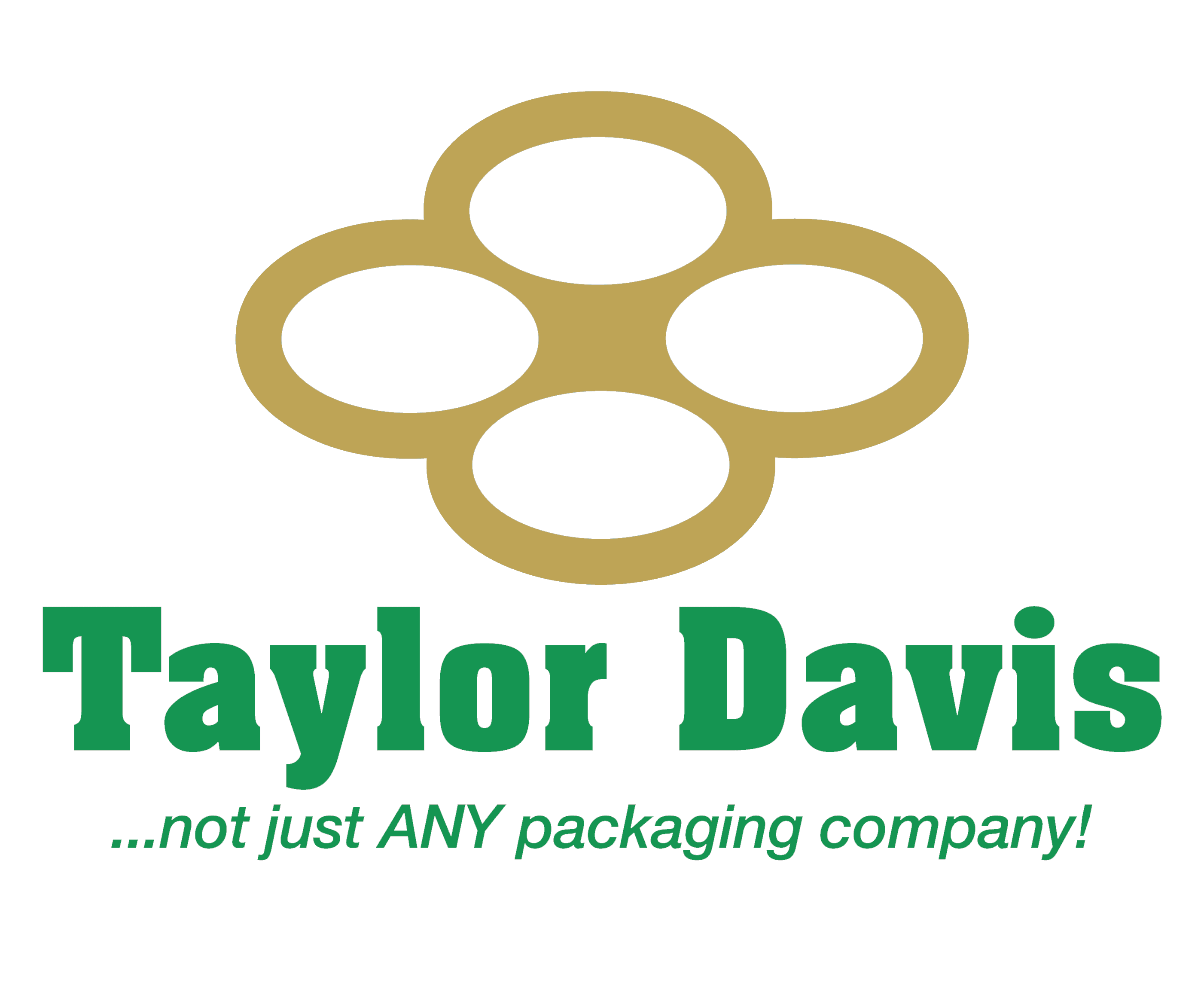The Ultimate Guide to Choosing The Right Plastic Bucket For Your Needs
It may seem like something small, but it’s seriously a big decision.
Choosing the right plastic bucket is not just about picking any old container off the shelf.
The best container can make all the difference depending on what you need it for, from household storage to industrial.
Here at Taylor Davis, it’s our mission to equip you with the best containers for your needs, so let’s get started.
Understanding Different Bucket Materials
Before delving into the various types of plastic buckets, it’s important to understand the materials used in their construction.
One of the most important things to consider is the material’s quality, especially when it comes to food-grade plastic buckets.
Among the materials commonly used, food-grade polypropylene (PP) stands out for its safety and durability:
Polypropylene:
PP is a versatile polymer with various grades and blends – although PP buckets are ideal for storing food, it is not limited to just food-grade applications.
While Polypropylene exhibits some chemical resistance, it’s crucial to note that it is not resistant to many chemicals. Although it can tolerate certain solvents briefly, it is not recommended for packaging such products into plastic – instead, consider metal cans.
Overall, PP buckets are easy to clean and maintain, making them perfect for food storage and transportation.
Other Common Materials:
While PP is a top choice for food, other materials like HPDE (high-density polyethylene) and LDPE (low-density polyethylene) are used in various bucket types, each with its specific advantages.
It is important to note that LDPE is primarily employed in blow moulding and is not suitable for injection moulding due to it’s limited stacking performance, which may lead to loss of shape.
Our long term supplier Jokey predominently opts for PP for almost all of their product range. The only exception is UN-approved buckets, for which they use HDPE due to its resilience in drop testing. Another of our suppliers CurTec however, are almost exclusively HDPE for their kegs & barrels.
Types of Plastic Buckets
Plastic buckets come in various shapes and sizes, each designed to suit different purposes.
Understanding the types available can help you make an informed decision.
- Heavy Duty: These are robust and durable, suitable for industrial and construction use. They can withstand heavy loads and rough handling, and can also be hot filled at +70°C too.
- Round Tapered: Often used in food service and surface coatings (paints & inks), these buckets have a tapered design which is great for stacking. They are delivered nested one inside the other, which offers significant storage advantages for empty packaging. This nesting feature is especially beneficial when compared to alternatives like plastic bottles or straight sided metal cans.
- Oval: These are a popular choice for equine and pet industries due to their ergonomic shape. This shape is also popular for packing retail paints as a roller can dipped straight into the bucket as opposed to a round bucket. This shape also offers a larger surface area for labelling/branding.
- Rectangular: Ideal for space-saving storage and transportation, commonly used in DIY projects. With the same benefits of the Oval this is a very versatile shape.
- Square: Square buckets qere primarily designed as a catering pack as their shape fitts neatly into limited small spaces in kitchens etc. As well as their stackability, these buckets are excellent for efficient storage and shipping.
Key Features
Apart from materials and types, specific features can enhance the functionality and safety of your plastic bucket.
- Tamper-evident: Especially crucial for food and surface coating uses, these lids provide security and protection against contamination.
- Stackability: If you need to save space in storage or transport, consider buckets that can be easily stacked to maximise efficiency.
- Protection against contamination: In food storage and medical use, buckets with seals can prevent contamination and spoilage.
Uses for Plastic Buckets
The versatility of plastic buckets makes them suitable for various applications:
- Food Storage: Food-grade plastic buckets are perfect for filling and safe transportating of various products.
- DIY materials: Whether you’re painting a room or mixing cement, plastic buckets can hold various materials securely.
- Gardening products: Gardeners use buckets for the storage of fertilisers and plant foods.
- Household storage: From toys to seasonal decorations, plastic buckets are excellent for organising and decluttering.
- Fishing baits and more: Anglers often use buckets to carry and store bait, while their durability makes them ideal for various outdoor activities.
What to Consider When Buying
As you browse through the options, keep these factors in mind:
Size and volume: Choose a size that matches your intended use, making sure it can hold the right amount without overfilling.
Intended use: Different applications require specific features, so select a bucket that aligns with your purpose.
Durability and strength: Consider the materials and build quality to ensure the bucket can withstand your intended tasks.
Price and brand reputation: While budget-friendly options exist, investing in a trusted brand can guarantee reliability and longevity.
As the UK agents & stockists for Jokey Group for over 40 years, Taylor Davis Ltd are well equipped to offer a comprehensive range of polypropylene tubs & buckets. Extensive stock holding in 3 depots; In Wiltshire (Head Office), Warwickshire and West Yorkshire.
The Range:
JET-P – Round tapered buckets from 2.2 litres up to 30 litres.The round bucket is the most popular packaging for liquid and solid products.
JET-B – Small capacity round tubs from 120ml up to 1560ml. Perfect for gourmet foods, ice cream and confectionery.
JET-R– Rectangular buckets from 3 litres up to 16 litres. The four corners ensure stability and optimum utilisation of the pallet.
JET-Q – Square Buckets from 1.5 litres up to 35 litres. The unusual shape guarantees effective advertising in square format.
JET-S – Small capacity rectangular tubs from 250ml up to 2.4 litres.Versatile, handy, convenient: JETS is ideal for your fresh products.
JET-O – Oval buckets from 2.5 litres up to 18 litres. The oval shape is ideal to satisfy the requirements of the construction chemicals industry.
Additional Considerations for Specific Applications
In addition to the fundamental factors mentioned earlier, it’s essential to delve deeper into specific applications to make an even more informed decision when choosing a plastic bucket.
- Chemical Storage:
If you intend to use a plastic bucket for storing chemicals, it’s crucial to select one that is compatible with the specific chemicals you’ll be handling.
Some chemicals may react with certain plastics, leading to structural damage or contamination. For most chemical applications, UN approved packaging will need to be used.
Always consult safety guidelines and chemical compatibility charts to ensure the bucket is suitable for the task.
- Food Storage Tips:
When selecting a plastic bucket for food storage, go beyond the food-grade label.
Consider additional features such as airtight seals and transparent walls that allow you to see the contents without opening the lid.
These features help maintain the freshness of ingredients and simplify inventory management.
- Tamper Evident Buckets:
For industries where product safety and consumer trust are paramount, tamper-evident buckets are a must.
These buckets come equipped with seals that break when the lid is opened, providing clear visual evidence of tampering.
They are commonly used in surface coatings, food packaging, and other sensitive industries.
- Lids and Accessories:
Depending on your application, you may require additional accessories like pour spouts,wet wipe dispensers, pumps that can be fitted for dispensing ketchups, mayo or mustards, or even buckets with built-in handles for ease of transport.
Carefully assess your needs to determine which accessories are essential.
- UV Resistance:
If your plastic bucket will be exposed to prolonged sunlight, such as in outdoor construction or gardening, consider buckets with UV resistance. Our range of PP buckets are only UV resistant when they are produced while employing specific ‘barrier’ polymers. The standard buckets are not impervious to UV light unless produced in black.
UV-resistant plastics are less likely to become brittle or discoloured when exposed to sunlight for extended periods.
- Recyclability:
For environmentally-conscious consumers and businesses, it’s important to choose buckets that are easily recyclable.
Look for recycling symbols and check with your local recycling facilities to ensure proper disposal options.
- Customisation Options:
Some manufacturers offer customisation options, allowing you to print logos, labels, or branding on your plastic buckets.
This is especially valuable for businesses looking to enhance their brand visibility or provide information directly on the bucket.
We offer two main types of printing on all of our Jokey plastic bucket range, these are:
In-Mould Labelling – In-Mould Labelling (IML) is the more popular choice when it comes to packaging decoration, due to the high-quality look and feel with unlimited decoration and colour options.
The technology works by placing a pre-printed plastic film label into a mould and the label is seamlessly fused to the thermoplastic material during the moulding process. This integrates the production of the container and the labelling process which means faster production time and lower costs.
Digital Printing – Digital printing, also known as heat transfer printing is the method of which acustom logo or design is printed onto a transfer paper then the ink is transferred thermally onto a container using pressure and heat.
This method also provides a high-quality photographic and seamless finish. However, there are limitations on the coverage on the container. Set up costs are more expensive than IML but are still reasonable.
Final Thoughts
Selecting the right plastic bucket may seem like a small decision, but it can have a significant impact on your business or daily life.
By being proactive and taking materials, types and key features into account, you can make an informed choice that suits your needs perfectly.
So, don’t underestimate the power of a well-chosen plastic bucket; it can be the difference between being successful and failing.
Ready to find the perfect bucket for your needs? Explore a wide range of high-quality Plastic Buckets today and make the right choice!


